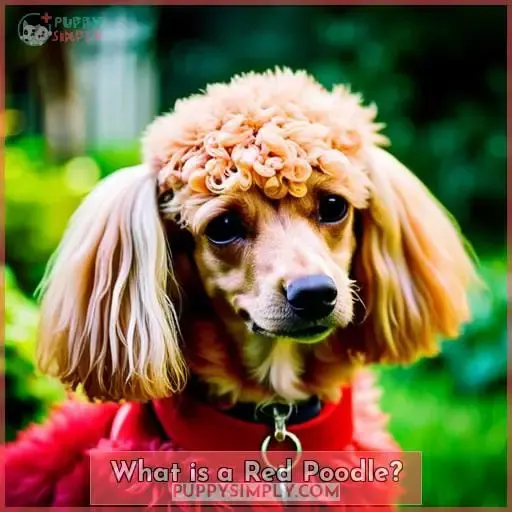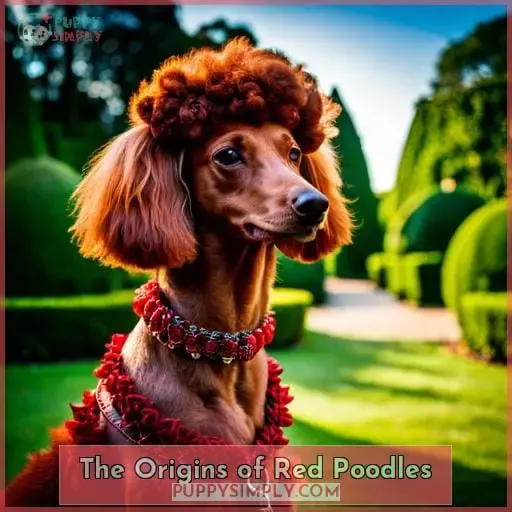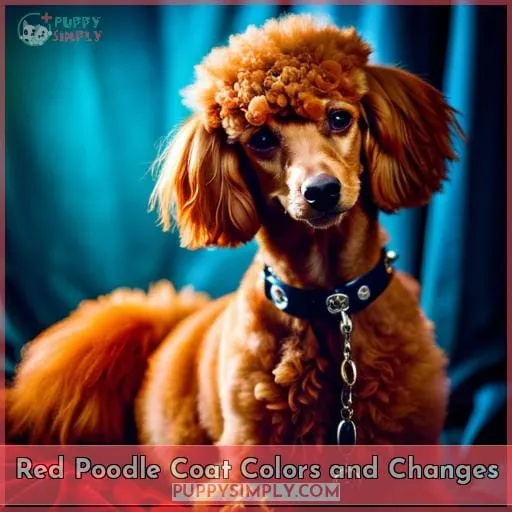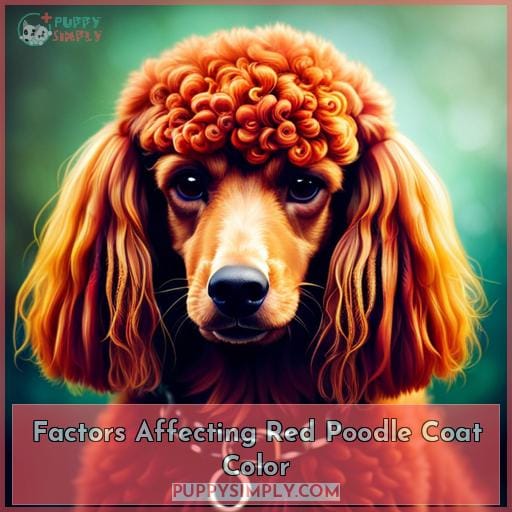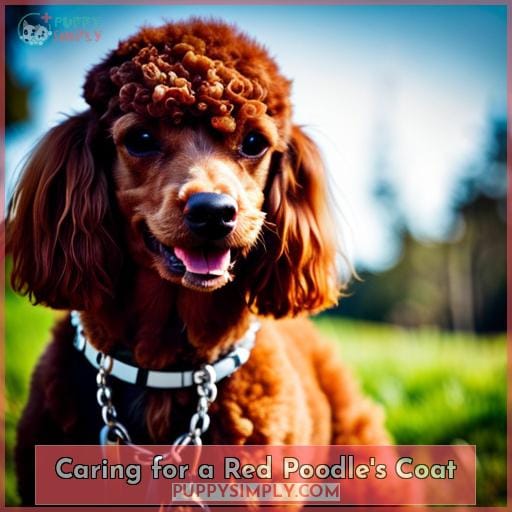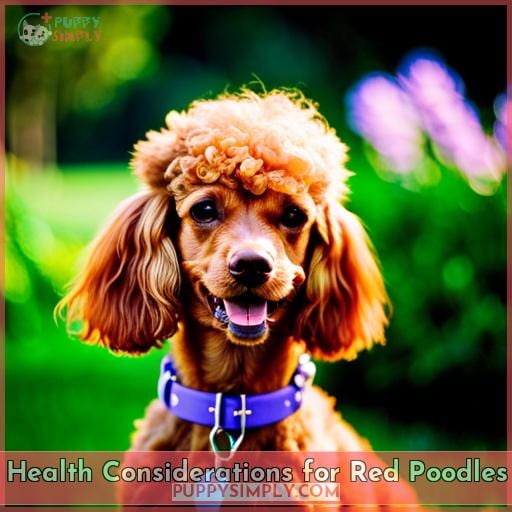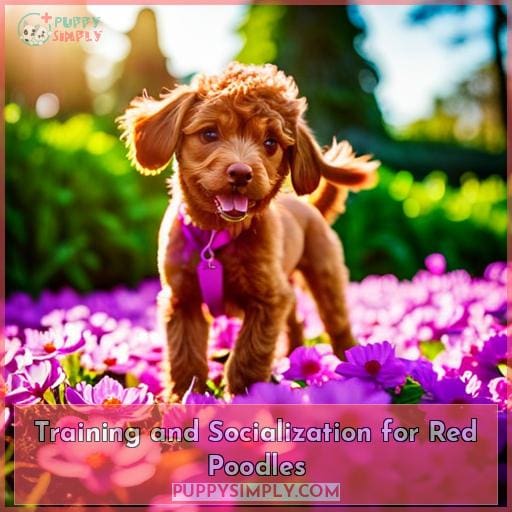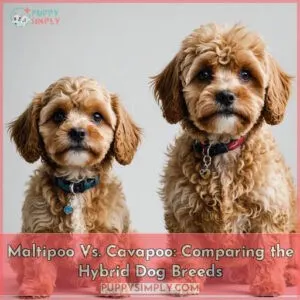This site is supported by our readers. We may earn a commission, at no cost to you, if you purchase through links.
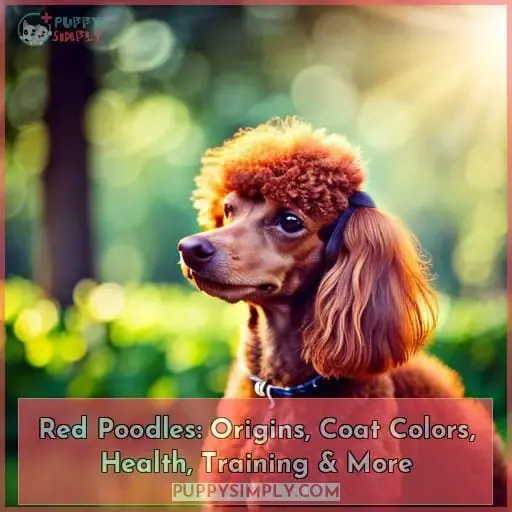 Toy Poodles are a vibrant, active breed of dog. They come in many shapes and sizes, but the red poodle stands out with its unique deep red coat that is sure to turn heads wherever they go.
Toy Poodles are a vibrant, active breed of dog. They come in many shapes and sizes, but the red poodle stands out with its unique deep red coat that is sure to turn heads wherever they go.
Red poodles were bred from dogs with apricot lines over time, and now they can be found all around the world. But there’s more to these lovely animals than their beautiful coats – let’s take a closer look at where this special breed comes from, how you can care for them properly, common health issues, training tips, and more.
If you’re lucky enough to have one of your own, you’ll know exactly what kind of commitment comes along with owning such an amazing pet!
Table Of Contents
- Key Takeaways
- What is a Red Poodle?
- The Origins of Red Poodles
- Red Poodle Coat Colors and Changes
- Factors Affecting Red Poodle Coat Color
- Choosing a Red Poodle: What to Look For
- Caring for a Red Poodle’s Coat
- Health Considerations for Red Poodles
- Training and Socialization for Red Poodles
- Red Poodle Names: Ideas and Inspiration
- Conclusion
Key Takeaways
- Red Poodles are recognized by the American Kennel Club and have a unique deep red coat color.
- There are four variations of Red Poodles: Standard, Miniature, Toy, and Teacup, each with their own characteristics.
- Red Poodles require regular grooming, dental care, and a proper diet to maintain their health.
- They are intelligent and easy to train when properly socialized, making them great companions for seniors and therapy dogs.
What is a Red Poodle?
You could have a unique canine companion with a Red Poodle, an exciting variation of the popular Toy breed that’s recognized by the American Kennel Club!
The red gene doesn’t affect black Poodles, and apricot is recessive to most coat colors except white. True red Poodles should have black points, though liver points are accepted but not preferred in the U.
S. Experimental breeding involved mating a miniature apricot female with a large standard red poodle for size increase over time.
Red poodles require more care from their humans. They need regular grooming and brushing, as well as dental care, to maintain healthy coats. Plus, health issues like Progressive Retinal Atrophy (PRA), Legg-Calvé-Perthes disease, or Tracheal collapse can occur if a proper diet isn’t maintained or obesity sets in due to a lack of exercise needs.
Training one is also easier than other breeds since they’re intelligent, eager to please, and easy-going around people when socialized properly at a young age.
The Origins of Red Poodles
Discovering the origin story for Red Poodles is like peeling an onion – there are many layers to uncover! Red poodles were officially recognized as a color by the AKC in 1980, thanks to Ilse Konig of Shangri-La Kennel and her experimental breeding program.
She mated a miniature apricot female with a large standard red male, producing four stunning puppies—the first Klein (or Moyan) Poodle litter.
Subsequent generations were bred from larger members of each litter in order to increase size over time. Red poodles can come from any other line so long as it contains the faded gene that gives them their russet hue; they have black points when true red but liver points are accepted in America although not preferred.
Color changes may occur during puppyhood or adulthood due to age and coat length/color variations caused by weather conditions; therefore maintenance products exist for keeping desired colors intact despite such shifts! Names often given include Amber, Blaze and Ruby—all indicative of their fiery coats!
Red Poodle Coat Colors and Changes
When it comes to Red Poodles, there are four variations of the breed: Standard, Miniature, Toy, and Teacup. Each has its own unique characteristics in terms of size and coloration – from light apricot to deep red.
It’s important for prospective owners to understand these distinctions before making a decision about this special breed.
Standard Red Poodles
Uncover the unique characteristics of Standard Red Poodles and how their red coats were developed. These dogs have a square body, proud bearing, and curly fur that doesn’t shed much.
Ilse Konig played an important role in creating this breed by mating a miniature apricot female with a large standard red male. This breeding produced four stunning puppies to be placed between Miniature and Standard categories – Klein or Moyan recognized in Europe.
Over time, size increased through selective litter-breeding, while the coat changed from bright to cinnamon during puppyhood or adulthood later on.
Consider these facts before choosing your Red Poodle companion – temperament, weather effects on coat color, as well as training tips for health considerations including names!
Miniature Red Poodles
Experimenting with the apricot and standard red poodles, breeders created miniature reds – but what makes them unique?
Miniature reds are smaller than standards and require less exercise. They have a curly coat that is usually black-tipped unless liver points are accepted in your region.
Grooming tips include regular brushing to maintain their color as it can change from bright red to cinnamon over time.
Behavioral tips involve providing mental stimulation and training techniques like agility or obedience classes, which they excel at due to their intelligence and eagerness to please.
Red toy poodles make excellent pets when properly groomed and socialized – just check out all the famous people who own them!
Toy Red Poodles
If you’re looking for a loyal, smart, and gentle companion with a unique coat color, consider Toy Red Poodles! They’re known for their sweet temperament and intelligence.
Taking care of their coat is easy since they don’t shed much. Health-wise, they’re prone to specific issues such as Progressive Retinal Atrophy (PRA) or Legg-Calve-Perthes disease.
Training these pups can also be an enjoyable experience as long as it’s done properly – reward positive behavior frequently! To add some personality to your pet’s life, choose from great red poodle names like Amber, Blaze, or Ruby.
With the right care and attention, Toy Red Poodles make excellent pets that will bring joy into your home for many years!
- Sweet Temperament & Intelligence
- Easy Coat Care with Minimal Shedding
- Prone to Specific Health Issues
- Rewarding Experience when Training Properly
- Unique Names like Amber & Blaze
Teacup Red Poodles
Discover how Teacup Red Poodles can be a perfect fit for your lifestyle and provide loving companionship.
Much smaller than their toy counterparts, teacup red poodles are 0-4 pounds in size. They require extra special care to maintain healthy coats with regular brushing and specially formulated color-enhancing products for the intense shade of red they sport.
You’ll need to keep an eye on their dental health too! Teacup poodle energy levels vary between calm and active, but they’re generally easy to train due to their intelligence, making them suitable even for first-time pet owners who may not have experience with dogs before!
Hot weather tolerant, these pooches can live up to 10-18 years if cared for properly, providing many years of lovable companionship that’s sure not to disappoint!
Factors Affecting Red Poodle Coat Color
Red Poodle coat colors can be affected by several factors, including weather and age. Weather conditions, such as dry cold or wet heat, can impact the intensity of a Red Poodle’s coloration, while aging may cause lighter shades to start appearing in the fur.
Weather and Coat Color
With changing weather, you may notice changes in your red Poodle’s coat color. Red Poodles are known for their unique genetics and can undergo various color changes depending on the season or temperature.
You might find that colder temperatures enhance the dog’s original red hue while hotter climates make it appear lighter and more apricot-like.
Age and Coat Color
As you age, your Red Poodle’s coat color may change from bright red to a more cinnamon hue. This is due to the faded gene present in these rare dogs and their genetics. It’s important to pay attention to dental health as well as exercise needs for overall pet care during this time of life.
Genetics play an important role in changes in a Red Poodle’s coat color throughout its lifespan.
Dental disease is prevalent among small breeds like Toy Poodles; regular brushing and check-ups are essential.
Exercise needs should be monitored regularly even into old age.
Socialization plays a key part in helping the dog become easier to train over time.
Grooming requirements should not be neglected.
Choosing a Red Poodle: What to Look For
When choosing a red poodle, look for a pup that has black points and an even coat color – like the litter of four stunning puppies bred from an apricot female miniature Poodle and a large standard red Poodle.
Pet parents should be sure to review these essentials on their checklist:
- Research potential breeders thoroughly to ensure they are reputable sources of quality Red Poodles.
- Make sure you understand the genetics behind Red Poodles’ colors so you can accurately identify them in different lights or at different ages when possible, as well as any associated health risks with those genes.
- Familiarize yourself with grooming techniques specifically for red-coated dogs such as brushing, bathing, ear care, and eye care; also get familiarized with products that help enhance color if necessary.
Red pups require special attention due to their unique coats — ask your breeder questions about proper nutrition, training methods best suited for this breed’s personality traits (as they tend towards being intelligent but independent), exercise needs, and other important information related to raising one successfully into adulthood!
Take time researching all aspects involved before bringing home this furry family member since these beautiful pets have specific needs compared with other breeds – many people find great satisfaction in properly caring for a Red Toy Poodle pet parent!
Caring for a Red Poodle’s Coat
Caring for a Red Poodle’s coat requires extra effort and attention. Regular grooming is essential to maintain the health of their luxurious locks, with specific tips and tricks to help keep their fur looking great.
Grooming Needs
Your poodle’s gorgeous red coat requires regular brushing and grooming to keep its luster.
Regularly brush the fur with a slicker brush to remove dirt and debris while stimulating natural oils for healthy skin and shine. For shedding control, consider using an undercoat rake or de-shedding tool at least once every couple of weeks during heavy shedding seasons.
Trimming should be done regularly by professionals as well, although you can do basic touch-ups between visits if needed.
Coat Care Tips
Regularly brushing and trimming your Poodle’s curls will keep them looking their best. Red Poodles have a unique coat that requires special attention, as the faded gene can cause their fur to fade over time.
As part of your routine grooming regimen, brush daily with an appropriate brush and comb out any tangles or mats in order to maintain the integrity of the coat.
Regular trimmings are also important for maintaining a healthy coat; this should be done every 6-8 weeks by a professional groomer who is familiar with red poodles’ specific needs.
With proper care and maintenance, you’ll ensure your pet looks its absolute best—even if it barks more than James Brown or King Louis XVI!
Health Considerations for Red Poodles
When it comes to red poodles, there are some health considerations that owners should be aware of. Common medical issues for these dogs include progressive retinal atrophy, patellar luxation, and Legg-Calvé-Perthes disease.
Common Health Issues
It’s important to be aware of the common health issues that may arise with your Red Poodle. Genetics can play a role in their lifespan, so it’s crucial to understand the breed and its traits before bringing one home.
Progressive Retinal Atrophy (PRA) can lead to blindness, while patellar luxation affects kneecap alignment and may require surgery. Legg-Calvé-Perthes disease is another potential ailment for young Toy Poodles’ femur head.
Dental care is very important due diligence for all breeds but especially smaller ones like red Poodles.
Early socialization, along with proper training, will help ensure longevity and happiness throughout their lives – work on obedience exercises together!
Regular Vet Check-ups
Schedule vet check-ups for your Toy Poodle to ensure optimal health. To maintain a Red Poodle’s good health, consider proper nutrition, adequate exercise, regular grooming and coat care, and behavioral enrichment activities.
Regular visits with the veterinarian are necessary to monitor their overall wellbeing, detect any potential medical issues early on, and keep up-to-date with vaccinations and other treatments.
Take note of changes in diet or behavior that could indicate an illness, such as coughing, weight loss, or aggression towards people/other pets, so you can discuss these during the visit.
Working closely together with your vet will help make sure that all aspects of Red Poodle health needs are met!
Training and Socialization for Red Poodles
If you’re considering a red poodle, be aware that their temperament is typically friendly and active. Training and socialization are key to ensuring your pup grows into an obedient, well-mannered companion.
Red Poodle Temperament
With their intelligence and eagerness to please, Toy Poodles are relatively easy to train and socialize. They have a strong-willed but gentle nature, which can lead to independence in some cases. However, they may display stubborn behavior when not given enough guidance and attention from an early age.
Consistent training is important for red poodles, and obedience classes can help them become well-rounded dogs with good manners.
Health care should also be part of their routine. Regular vet visits and proper nutrition are essential to keep them healthy both mentally and physically, which in turn helps them behave better in different situations, such as around other pets or strangers.
Additionally, grooming needs must not be neglected. Regular brushing helps keep tangles away and also strengthens the bond between the dog and its owner during quality time together.
Training Tips
To ensure your Red Poodle is well-behaved and a good companion, regular training is essential – just like teaching an eager student.
- Establish yourself as the leader of the pack by providing consistent boundaries and expectations to your pup.
- Use positive reinforcement during obedience sessions, such as treats, verbal praise, or a favorite toy, when they complete commands correctly.
- Socialize them early with other canines to prevent any fear aggression later in life from developing.
Training challenges may arise due to their independent nature. Use patience while redirecting energy into acceptable activities whenever necessary for optimum success in behavioral modification techniques and socialization techniques alike!
Socialization Tips
Getting your red poodle used to interacting with other people and animals is key to a well-socialized pup. Start early by exposing them to different sights, sounds, smells, and textures in the environment.
Allow safe interactions with other canines and humans so they become comfortable around them. Use positive reinforcement during training sessions for the best results while teaching commands such as sit, stay, or come when called.
Introduce new canine companions slowly, but make sure both dogs are supervised until you know how they will get along together. This helps build trust between the two of them, which leads to increased socialization skills.
With patience and consistency, your red poodle will soon be enjoying life’s adventures alongside their canine companions!
Red Poodle Names: Ideas and Inspiration
Unleash your creativity and explore a world of possibilities with unique red poodle names! Red Poodles have become increasingly popular due to their stunning color variations. From ruby red to cinnamon-colored coats, these dogs stand out in the canine crowd.
When choosing your pup’s name, consider its coat variation or breeding history for inspiration. Ruby is an obvious choice for deep crimson coats, while Blaze fits brighter shades perfectly.
For those looking into red Poodle care tips and health concerns associated with this breed—such as Progressive Retinal Atrophy (PRA) or Legg-Calvé-Perthes disease—try naming your pup after medical terms such as Amaurosis (a type of blindness), Luxation (kneecap alignment), and Femur Head (the top end of the femur).
Finally, if training is on the agenda for your little one then look no further than obedience commands like Sit & Stay which would make great monikers too! No matter what you choose it’ll be sure to show off just how special they are – so get creative today and pick out a fitting name that reflects all that’s wonderful about them!
Conclusion
Ultimately, the red poodle is a unique and attractive breed of dog. With its cheerful personality, intelligence, and adaptability, it is a wonderful choice for those who are looking for a loyal companion.
The vibrant red coat is sure to draw attention and admiration, and because of its rarity, it will make your pup truly stand out. Although they require more care and attention than other breeds, with their longer coats and sensitive nature, a red poodle can be a beautiful part of the family—one that will bring joy and love to all.

